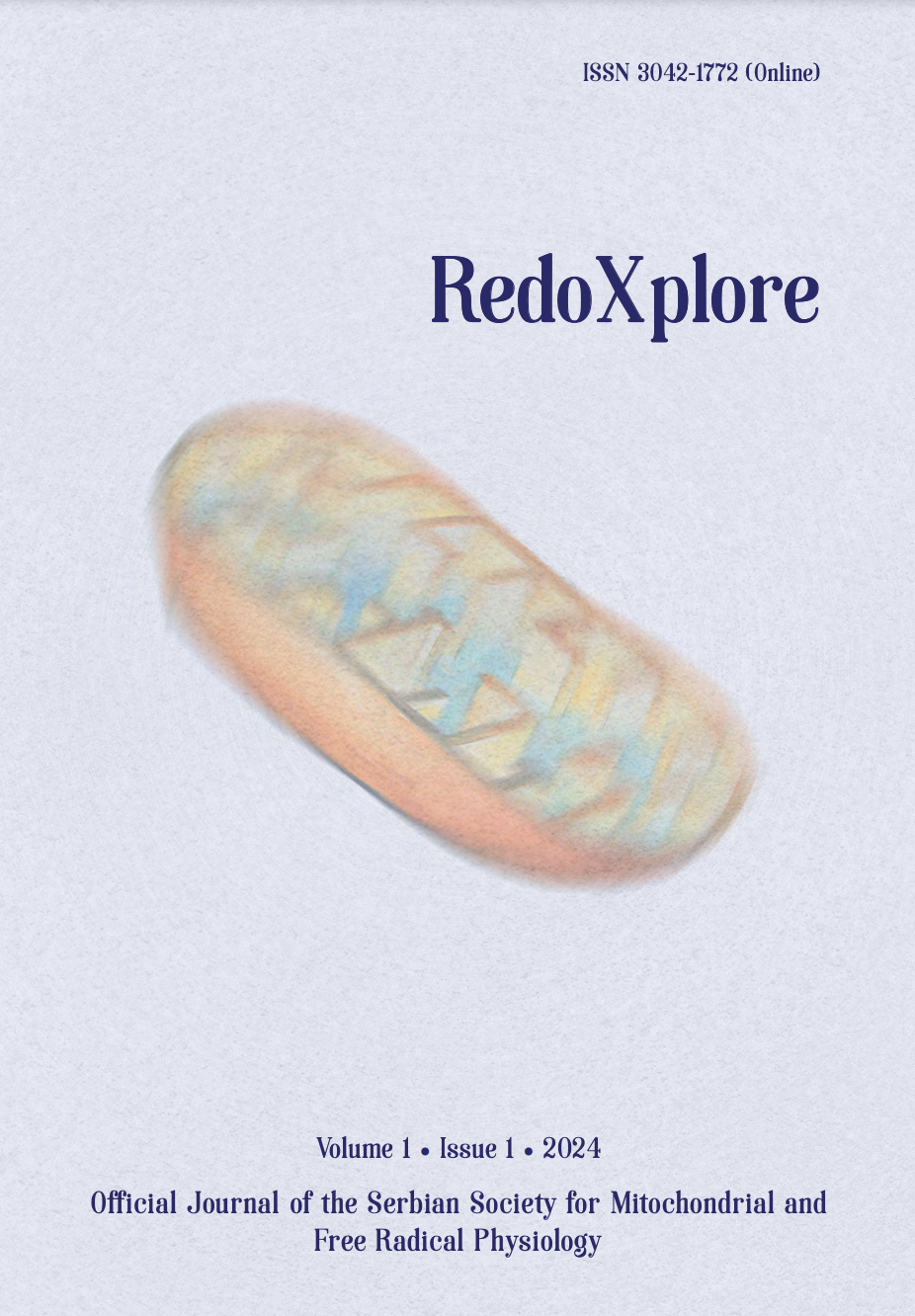
More articles from Volume 1, Issue 1, 2024
REDOX AND METABOLIC REPROGRAMMING OF BREAST CANCER CELLS AND ASSOCIATED ADIPOSE TISSUE - THE CORNERSTONES OF ADAPTIVE TUMOUR BEHAVIOUR
INSULIN MODULATES MITOCHONDRIAL STRUCTURAL AND FUNCTIONAL MOSAICISM IN BROWN ADIPOCYTES
NITRITE MITIGATES OXIDATIVE BURST IN ISCHEMIA/REPERFUSION IN BRAIN SLICES
NITRIC OXIDE, SUPEROXIDE AND PEROXYNITRITE – REDOX REGULATION OF THE CARDIOVASCULAR SYSTEM BY NITRO-OXIDATIVE STRESS AND S-NITROS(YL)ATION
DIETARY NITRATE AS PIVOT ON THE GUT MICROBIOTA-HOST REDOX COMMUNICATION
ABERRANT MITOCHONDRIA-INFLAMMASOME CROSS-TALK IN RETT SYNDROME
Department of Animal Sciences, Plants for Human Health Institute, NC Research Campus, NC State University , Kannapolis , United States
Department of Environmental Sciences and Prevention, University of Ferrara , Ferrara , Italy
Department of Food and Nutrition, Kyung Hee University , Seoul , South Korea
Department of Animal Sciences, Plants for Human Health Institute, NC Research Campus, NC State University , Kannapolis , United States
Department of Environmental Sciences and Prevention, University of Ferrara , Ferrara , Italy
Department of Environmental Sciences and Prevention, University of Ferrara , Ferrara , Italy
Toscana Life Science , Siena , Italy
Department of Translational Medicine and for Romagna, University of Ferrara , Ferrara , Italy
Department of Animal Sciences, Plants for Human Health Institute, NC Research Campus, NC State University , Kannapolis , United States
Department of Environmental Sciences and Prevention, University of Ferrara , Ferrara , Italy
Editor: Bato Korac
Published: 29.08.2024.
Keynote lectures
Volume 1, Issue 1 (2024)
Abstract
Rett syndrome (RTT), a devastating neurodevelopmental disorder, is caused in 95% of the cases by mutations in the X-chromosome-localized MECP2 gene. RTT manifests as a range of multisystem disturbances including altered lipid profile, subclinical inflammation, and overall OxInflammatory status in which mitochondrial dysfunction acts as central player. To decipher the molecular mechanisms underlying the pathophysiological manifestations affecting patients, we investigated whether mitochondria may play a role in the aberrant immune and oxidative responses of RTT. Recent findings from our and other labs unraveled several abnormalities in RTT mitochondria including atypical mitochondrial structure, deregulated expression of genes encoding oxidative phosphorylation factors and mitochondrial organization factors, impaired mitochondrial quality control, depressed energetic profile, and augmented mt-ROS production. In other brain diseases, mitochondrial dysfunction is a vital event during the activation of NLPR3 inflammasome, a multi-protein complex involved in innate immune response, that represents a common denominator in the crosstalk between inflammation and oxidative stress. Interestingly, using primary fibroblasts and lympho-monocytes isolated from RTT patients, we found a constitutive hyperactivation of NLRP3:ASC inflammasome associated with increased levels of nuclear p65 and ASC proteins, and pro-IL-1β mRNA, without the ability to further respond to the LPS + ATP stimuli. Furthermore, increased circulating levels of ASC, interleukin (IL)-18, and 1β were found in RTT individuals, thus corroborating the aforementioned cellular findings. In order to evaluate NLRP3 involvement in the transition from pre-symptomatic to symptomatic phase of RTT, we detected higher serum levels of IL-1β and IL-18 in symptomatic Het mice compared to WT. Of note, increased gene expression of Il-1b, Nlrp3, and ASC was observed in Het brains at the pre-symptomatic stage, suggesting a likely role of NLRP3 impairment in the early stages of the disease. Preliminary data showed that treatment with resveratrol, known to improve mitochondrial function, ameliorated the RTT mouse phenotype by restoring levels of some NLRP3-related components. Furthermore, mitochondrial dysfunction can result in ferroptosis, a form of cell death characterized by iron-dependent lipid peroxidation and accumulation of reactive oxygen species. After treatment with two ferroptosis inducers, erastin (GPX4 inhibitor) or RSL3 (inhibitor of the cystine/glutamate antiporter), we found changes in GPx and GR activity, alteration in GPX4 protein levels and increased formation of 4HNE protein adducts. Mitochondrial ROS production and lipid peroxidation levels were higher in RTT after ferroptosis induction, while co-treatment with ferrostatin-1, a well-known inhibitor of ferroptosis, significantly prevented these processes. Interestingly, co-treatment with mito-TEMPO, a mitochondria-targeted superoxide dismutase mimetic, mitigated mitochondrial oxidative burden and prevented ferroptosis cell death in RTT cells. Overall, our results demonstrate the decisive role of mitochondrial dysfunction in RTT OxInflammation. Thus, we can speculate that exposure of RTT cells to any condition affecting the already compromised mitochondrial function could not only hyperactivate the inflammatory status but also precipitate ferroptosis cell death. Targeting mitochondria in RTT could represent a strategic coadjuvant therapy to improve the quality of life of the affected patients.
Citation
Copyright

This work is licensed under a Creative Commons Attribution-NonCommercial-ShareAlike 4.0 International License.
Article metrics
The statements, opinions and data contained in the journal are solely those of the individual authors and contributors and not of the publisher and the editor(s). We stay neutral with regard to jurisdictional claims in published maps and institutional affiliations.






